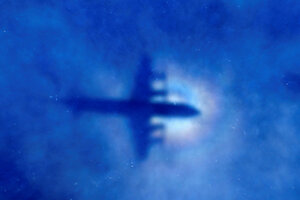Tragic disappearance of flight MH370 spurs changes to aviation standards
Investigators from Malaysia, China, and Australia suspended the two-year search for MH370 this week, but the flight's disappearance is encouraging new safety standards for the future.

The shadow of a Royal New Zealand Air Force (RNZAF) P3 Orion maritime search aircraft can be seen on low-level clouds as it flies over the southern Indian Ocean during a March 2014 search for missing Malaysian Airlines flight MH370.
Rob Griffith/Reuters/File
Investigators from Malaysia, Australia, and China say they will suspend their search for Malaysian Airlines flight MH370 in December after more than two years of fruitless searching.
“In the absence of new evidence, Malaysia, Australia and China have collectively decided to suspend the search upon completion of the 120,000 square kilometer (46,332 sq mile) search area,” Malaysian Transport Minister Liow Tiong Lai said in a statement Friday after meeting with fellow Australian and Chinese officials.
“Should credible new information emerge which can be used to identify the specific location of the aircraft, consideration will be given in determining next steps.”
The Boeing 777 disappeared on March 8, 2014 while en route to Beijing from Kuala Lumpur, Malaysia with 239 passengers and crew on board. Experts believe the flight turned back to Malaysia mid-route before falling into the Indian Ocean somewhere west of Australia.
And while Malaysian Airlines flight MH370 remains one of the greatest – and most tragic – aviation mysteries, the plane’s disappearance has encouraged new safety regulations.
The International Civil Aviation Organization (ICAO), the UN agency that sets global aviation regulations, announced new safety regulations in March. Now planes in distress will have to report their position to ground control every minute and have easier means to recover planes’ “black boxes,” flight recorders that store cockpit audio and and other instrument data, after a crash.
One possibility is deployable recorders. Used in military aircraft, a deployable recorder would automatically eject from the airplane and float to the water’s surface. But Boeing voiced uncertainty over this proposal, predicting that the technology would allow the recorders to accidentally deploy upon non-threatening impact, potentially injuring passengers, flight crew, or the plane itself.
However, the every-minute reporting system will only be required for planes built six years from now, and sophisticated black box retrieval may take more than a decade.
But the ICAO has announced other safety changes for the near future. By November 2018, all airlines will be required to report their location every 15 minutes when flying over open ocean, instead of the current protocol which requires location reporting every 30 minutes. A more frequent reporting system will allow investigators to create a narrower search area if something were to go wrong.
But investigators worry that all of these new safety measures won’t be implemented in a timely manner, Chris Hart, the chairman of the US National Transportation Safety Board, told the Associated Press in March.
"We are concerned about the slow pace of progress at both the national and international levels. We believe this is long overdue," he said.
Authorities expect to finish searching the 38,610 square miles of the Indian Ocean seabed by December, after which the search will be indefinitely suspended unless new tips arise.
Several next-of-kin, who were present at the briefing, say they appreciate the term “suspended.”
“This means authorities are committed to finding answers and not just quitting,” K.S. Narendran from Chennai, India, whose wife Chandrika Sharma was on board, told the Agence France-Presse. “This is to be welcomed.”
This report includes material from the Associated Press.

